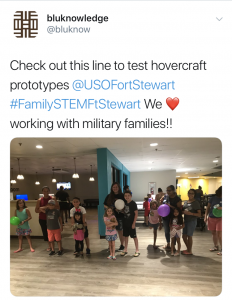How did this idea come about?
 About a year ago, I received a call from Dr. M. David Burghardt (Dave), professor at Hofstra University and co-director of the Center for STEM Research. He wanted to know if I would be interested in piloting the WISE Guys and Gals (WGG) engineering program with military families, especially families with a deployed parent.
About a year ago, I received a call from Dr. M. David Burghardt (Dave), professor at Hofstra University and co-director of the Center for STEM Research. He wanted to know if I would be interested in piloting the WISE Guys and Gals (WGG) engineering program with military families, especially families with a deployed parent.
Of course! We gladly welcomed the opportunity to determine the best ways to support family engagement and STEM learning. After sharing our connections to the US military, we knew this pilot was a go!
Dave, a graduate of the US Merchant Marine Academy, spoke of his sister who was a Navy wife, and his mother who taught school with many children from military families. I confessed I was a “military brat”. My dad served in the Air Force for 22 years, which enabled me to live in two countries and four states, and learn in eight schools. I am also married to an Army veteran and a sibling to active Army soldier, who’s been deployed at least twice.
Motivation. Buy-in. Check.
Recognizing the hardships military families face during times of deployment, and in general with frequent relocations, Dave and I believed families might benefit from the levity and connectedness that STEM learning offers.
Our goal: Engage families in fun, technology-enabled STEM learning experiences worth sharing!
These “experiences worth sharing” give families more reasons to connect and communicate, hopefully leading to increased family togetherness.
How did we get going?
To start, we needed to figure out the best point of contact, national or local, to determine interest and fit. After a series of introductions and email exchanges, and several (ongoing) tutorials in army hierarchy and naming conventions, we connected with the 1-41 Field Artillery, 3rd Infantry Division on Fort Stewart in Georgia. A meeting with their Family Readiness Group (FRG) liaisons and leaders helped us consider ways to adapt our current WGG Family STEM Program with Parent University to best meet the needs of their families on Post.
As a result, we
- changed our participation model from a focus on parent/caregiver during the in-person session and parent/caregiver and family interaction at home to local family unit during the in-person session and deployed parent and local family interactions at home

- hired a program assistant, Candace McNeal, who also grew up in the military; her mother served 21 years in the Marines (Right!? This project is kismet!)
- updated our data collection tools and processes to ensure all families had an opportunity to share their STEM learning experiences with their deployed parent whether he/she was able to complete the engineering design challenge or not (We recognize they are on mission and this would be an additional ask).
So what happened?
We had F-U-N! After working out a few logistical kinks (pilots help us figure out processes and experiences for participants and partners!), we held session number one just last week at the USO on Fort Stewart, GA. Eleven families (11 mothers, 1 grandmother, and 23 children ages 1-15 years old) engaged in the engineering design cycle to complete the Hover Above It All (hovercraft) engineering challenge.
Families used mobile devices with WGG engineering challenge software to





At the end of our session, we provided families the opportunity to share their experiences as a story in a format that aligns with their family communication style. All families left the event with an activity kit (includes inexpensive supplies and an activity guide with suggested questions to discuss with their children) to complete the engineering challenge again at home (hopefully with design insights that lead to a revised prototype).
For families with a deployed parent, we provided an additional activity kit for them to send to their deployed parent. It is our hope that the deployed parent
- completes the engineering challenge with their family using the WGG engineering challenge software, which allows them to see each other responses, pictures, and video, or video apps, such as Google Hangout, FaceTime, or Skype
- completes the engineering challenge on his/her own or with fellow soldiers and compare experiences with their family via phone, video, or text
- simply listens and discusses their children’s experiences with the engineering challenge.
What’s next?
Again, our goal was to provide an STEM learning experience worth sharing. The WGG Family STEM program provided local families opportunities to connect with each other through conversation and teamwork as they engaged in problem-solving. In time, we will learn how this blended STEM learning experience affected communication between local and deployed family members. In the meantime, we look forward to repeating this event and learning more about how to design blended STEM learning as one tool that can support family togetherness near and far.
Closing Remarks
As we were cleaning up, I noticed that two women having a conversation about their families and the effect of deployment on their children. Meanwhile, their children played together in the USO. It reminded me that the benefit of family engagement programs like WGG Family STEM is not limited to increasing togetherness within a family unit. It also establishes time, space, and a shared experiences for families to connect with one another, which after all is the basis for building community.
We extend a special THANK YOU to all military personnel for protecting our freedoms and their families for “holding down the fort” so they can!



